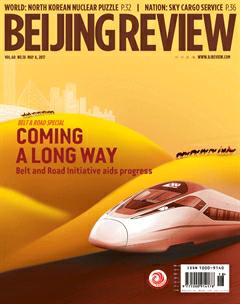A Forex Balancing Act
By+Lan+Xinzhen
Reports in Western media on the huge amount of capital flowing out of China and the Chinese Government imposing restrictions over money outfl ows in recent years had cast a shadow on the hearts of investors. But now they may feel relieved by a new set of statistics issued by the State Administration of Foreign Exchange (SAFE), which shows the demand for and supply of foreign exchange was approaching equilibrium in the fi rst quarter.
According to SAFE statistics, banks settlements in foreign currencies increased by 7 percent year on year in U.S. dollar terms, while foreign currency sales dropped by 12 percent. The settlement-to-sales deficit stood at$40.9 billion, down by 67 percent over the same period in 2016. International receipts through banks increased by 2 percent year on year, while payments dropped by 9 percent, with a defi cit of $25.2 billion—a decline of 78 percent compared with the same period in 2016.
According to the data, capital outfl ows clearly slowed down in the first quarter of the year. Since the second half of 2014, China has seen net capital outflows. Its foreign exchange reserves have also kept dropping. The reasons why capital kept hemorrhaging out of China can mainly be attributed to expectations of interest rate hikes by the U.S. Federal Reserve, Chinas rising outbound investments, and the outside worlds concerns regarding the Chinese economys development.
The Peoples Bank of China (PBOC), the countrys central bank, and SAFE interpreted the massive capital outfl ows as an opportunity to promote the opening up of Chinas fi nancial market. In the short term, the authorities are seeking to reach a balance between foreign exchange receipts and payments, and to prevent risks in cross-border capital fl ows. In the long run, their goal is to push forward capital account convertibility. In February 2016, the PBOC announced that it would expand access to the Chinese market for foreign institutional investors, so that more such investors would be able to invest in Chinas inter-bank bond markets. Since May 2016, these investors have been required to get registered, without limitations on individual or overall quotas. Inward and outward remittances are required to be largely in the same currency. All these moves are designed to reduce the impact of large-scale inbound and outbound fl ows of capital on the balance of international payments.
By the end of December 2016, more than 180 foreign institutions or funds had got registered at the PBOC Shanghai Head Offi ce. Reforms of foreign currency management targeting qualifi ed foreign institutional investors and renminbi-qualified foreign institutional investors were launched in February and August 2016, respectively, which raised the investment quota for individual institutions, simplifi ed the approval process and reduced the lock-up period from one year to three months—which improved the fl ow of capital.
So far, these measures have produced good results. The drop in foreign exchange reserves in 2016 was 38 percent less compared with that in 2015. Moreover, in February and March this year, Chinas foreign exchange reserves rebounded.
The data issued by the National Bureau of Statistics on April 17 have bolstered the markets confidence in the stabilization of the Chinese economy. In the first quarter, the Chinese economy grew by 6.9 percent over the same period last year, 0.1 percentage point higher than the growth rate in the previous quarter. A lot of economic indexes are improving. For example, the official manufacturing purchasing managers index grew for eight months, to 51.8 percent in March—the highest since May 2012.
Externally, although the U.S. Federal Reserve raised its benchmark rate in March, the U.S. dollar index, which measures the value of the dollar against other select currencies, fluctuated only within a narrow range, and dropped 1.8 percent in the fi rst quarter.
With the smooth development of a market-based exchange rate regime in China following the renminbis inclusion in the International Monetary Funds special drawing rights basket on October 1, 2016, the fl exibility of the currencys exchange rate will also increase, which will help promote two-way fl ows of capital.
The internal and external factors mentioned previously have bolstered investors confi dence in the Chinese market. According to a report by the UN Conference on Trade and Development, China ranked third on the list of economies receiving capital infl ows in 2016. The fi rst two on that list were the United States and the United Kingdom.
China will push forward the opening up of its capital account in a prudent manner. Any further tightening of its foreign exchange management policies is impossible. As Wang Chunying, spokesperson of SAFE, said on April 19, the window which was opened will not be shut. This is a strong assurance of free and convenient transnational capital fl ows.
Of course, China will try to prevent risks in crossborder capital flows as well as any negative impact on its financial stability. It will safeguard the healthy development of its foreign exchange market with prudent supervision and market monitoring systems.

